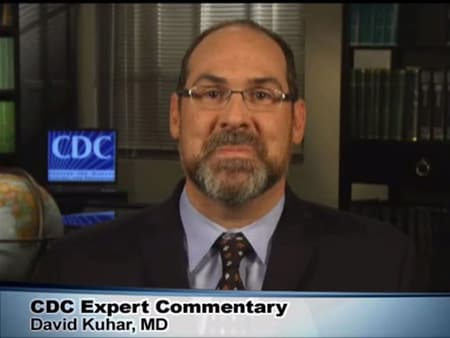 "Hello. I'm Dr. David Kuhar, a medical officer at the Centers for Disease Control and Prevention (CDC). I'm pleased to be speaking with you today as part of the CDC Expert Video Commentary series on Medscape. Today I want to discuss what healthcare facilities can do to prepare for a patient with Ebola virus disease and the infection control procedures that need to be in place in US hospitals.
"Hello. I'm Dr. David Kuhar, a medical officer at the Centers for Disease Control and Prevention (CDC). I'm pleased to be speaking with you today as part of the CDC Expert Video Commentary series on Medscape. Today I want to discuss what healthcare facilities can do to prepare for a patient with Ebola virus disease and the infection control procedures that need to be in place in US hospitals.
The recent Ebola virus disease outbreak in West Africa has increased the possibility of patients traveling from the affected countries to the United States. Furthermore, 2 American citizens with Ebola were medically evacuated to the United States to receive care at a hospital.
Any US hospital that is following CDC's infection control recommendations, and can isolate a patient in a private room, is capable of safely managing a patient with Ebola virus disease.
Early recognition is critical for infection control. Any suspected case needs to be isolated until the diagnosis is confirmed or ruled out.
Healthcare providers should consider Ebola as a diagnosis when patients have traveled to affected areas within the past 3 weeks and report such symptoms as fever, joint or muscle aches, diarrhea, vomiting, weakness, stomach pain, or lack of appetite.
Patients should be isolated in a single-patient room containing a private bathroom, with the door to the hallway closed. Limit the number of persons entering the patient's room to those essential for care, and maintain a log of all persons entering the patient's room.
Anyone entering the room should wear at least gloves, a gown that is fluid resistant, eye protection such as goggles or a face shield, and a face mask. Additional personal protective equipment (PPE) might be required in certain situations, such as when there may be copious amounts of blood or other body fluids present in the environment. For these situations, additional PPE could include, but is not limited to, double gloving, disposable shoe covers, and leg coverings. Upon exit from the care area, it is very important that PPE be carefully removed and discarded without contaminating the wearer's eyes, mucous membranes, or clothing with potentially infectious materials. Reusable PPE -- such as some types of goggles -- should be cleaned and disinfected according to the manufacturer's reprocessing instructions and hospital policies.
When caring for the patient, dedicated and disposable medical equipment is preferable, when possible. All nondedicated, nondisposable medical equipment used for patient care should be cleaned and disinfected according to the manufacturer's instructions and hospital policies.
Limit the use of needles and other sharps as much as possible. Phlebotomy procedures and lab testing should be limited to the minimum necessary for essential diagnostic evaluation and medical care. Also, all needles and sharps should be handled with extreme care and disposed of in puncture-proof, sealed containers.
We recommend avoiding aerosol-generating procedures for patients infected with Ebola virus disease. If these procedures are performed, you should follow CDC's detailed infection control recommendations, which can be found in the resources section on this page.
Diligent environmental cleaning and disinfection and safe handling of potentially contaminated materials are paramount, because blood, sweat, emesis, feces, and other body secretions represent potential infectious materials. Healthcare personnel performing environmental cleaning and disinfection should wear recommended PPE and consider use of additional barriers such as shoe or leg coverings.
The duration of precautions should be determined on a case-by-case basis, in conjunction with local, state, and federal health authorities.
I have described our minimum recommendations. If hospitals decide to add additional precautions, they should have staff practice the procedures and practice using the PPE in advance. Changing to unfamiliar equipment may lead to breaches in safe practices and may increase a person's risk of contaminating their clothes, mouth, or eyes, especially when removing the equipment. So, practice these protocols in advance.
As this outbreak continues to evolve, CDC will regularly update our Ebola Website and will continue to release additional resources for US healthcare facilities. Please continue to check back to stay up-to-date on the evolving situation or to view the additional resources available on this page".
Web Resources
Dr. David Kuhar is Medical Officer in the Division of Healthcare Quality Promotion at the CDC. He received his MD degree from Emory University, completed his residency in internal medicine at New York University Medical Center, and completed a fellowship in infectious diseases at Mt. Sinai Medical Center in New York. Dr. Kuhar came to CDC in 2010. As part of his role at CDC, he continues to serve as a subject matter expert on emerging pathogens, develops clinical guidelines regarding infection prevention in healthcare settings, and participates in investigations of infectious diseases outbreaks in healthcare.
No hay comentarios:
Publicar un comentario